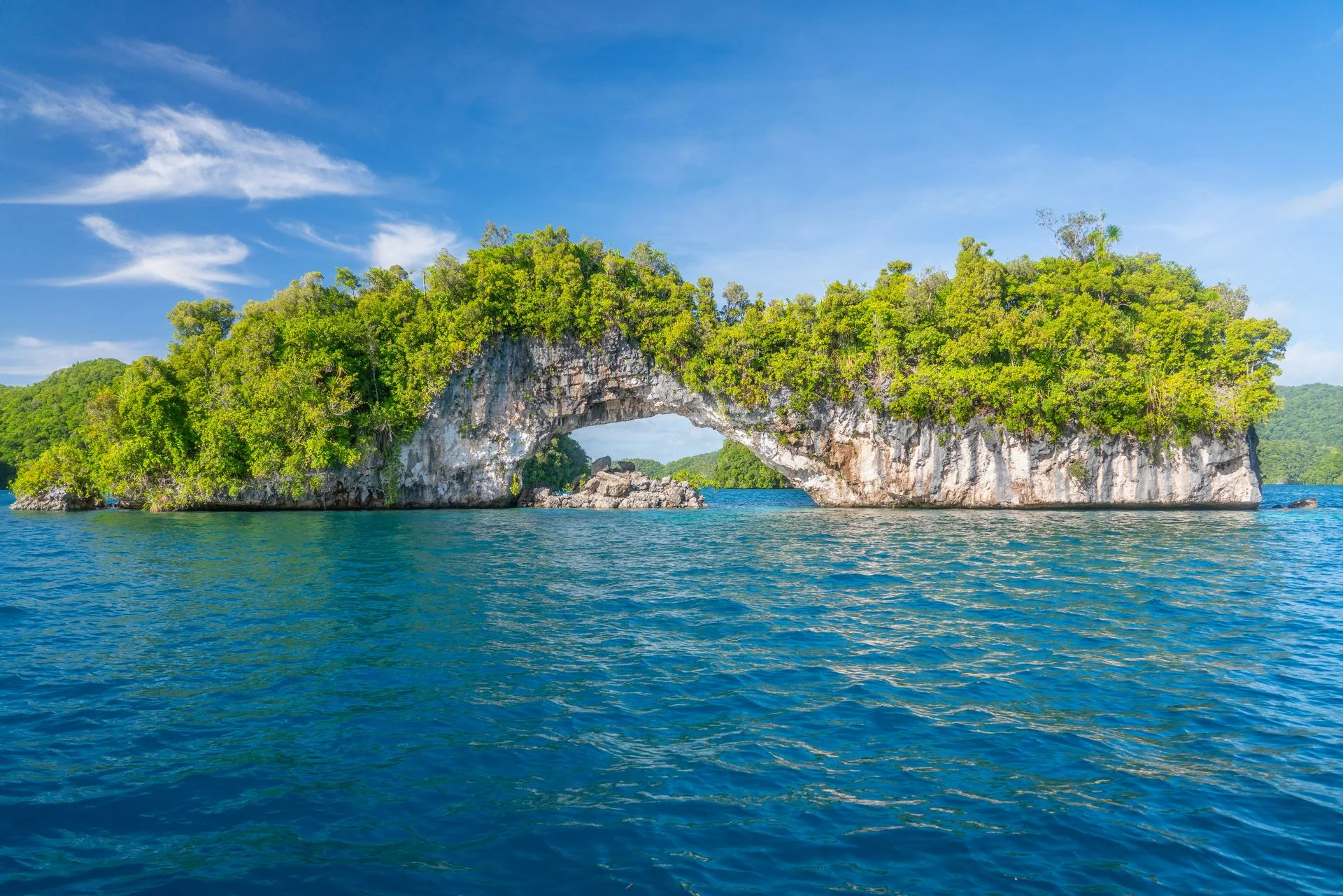Scuba Diving in Palau
The Ultimate Guide
Rising out of the western Pacific at the meeting point of two great oceans, Palau is an archipelago of more than 500 jungle‑cloaked islands and limestone rock pinnacles. Its barrier reef and scattered outcrops create caverns, walls, tunnels and channels where nutrient‑rich currents sweep in from the Philippine Sea. These flows feed carpets of hard and soft corals and attract vast schools of jacks, barracudas and snappers, as well as an impressive cast of pelagics. Grey reef and whitetip sharks parade along the legendary Blue Corner; manta rays glide back and forth through German Channel’s cleaning stations; and Ulong Channel offers a thrill‑ride drift over giant clams and lettuce corals. Between dives you can snorkel among non‑stinging jellyfish in Jellyfish Lake or explore WWII ship and plane wrecks covered in colourful sponges.
Difficulty
Advanced
Temperature
27–30 °C
Visibility
15–40 m

Diving Highlights
Best Months to Dive
Getting to Palau for Diving
✈️Transportation
Fly into Roman Tmetuchl International Airport (ROR) on Babeldaob Island, which is connected by causeway to Koror, Palau’s main town.
Palau receives direct flights from Guam, Taipei, Tokyo, Hong Kong, Macau, Manila and Seoul.
From the airport it is a 15‑minute drive to most hotels and dive centres in Koror.
Dive operators provide daily boat transfers to the Rock Islands and outer reefs.
Liveaboards depart from Koror harbour and usually include airport pick‑ups.
Country
Palau
Currency
US Dollar
Electricity
120 V, 60 Hz, Type A/B (US) plugs
Cost of a Dive Trip in Palau
Day Trip
Liveaboard
Meal
Accommodation
Best Dive Sites in Palau
🐠Blue Corner
Perhaps Palau’s most famous dive, Blue Corner is a V‑shaped plateau jutting into the Philippine Sea. Divers hook into the reef edge to watch an endless procession of grey and whitetip reef sharks, Napoleon wrasse and swirling schools of barracudas and jacks. The strong incoming currents also bring pelagics like sailfish and hammerheads.
🐢German Channel
Dredged during the German colonial era, this channel connects the lagoon to the open ocean and acts as a highway for large pelagics. Manta rays line up at cleaning stations, reef sharks patrol the sandy bottom and the surrounding reefs are home to macro life. Diving is best on an incoming tide when visibility is highest.
🦈Ulong Channel
A natural channel between two reefs covered in lettuce corals and giant clams. Divers start at the mouth and let the current propel them along the sandy floor past resting sharks and schooling jacks. At the end of the drift is a spectacular coral garden where you can surface safely.
🐙Blue Holes & Blue Hole
A series of interconnected vertical shafts in the reef top lead down to a huge cavern opening out onto the wall. Rays of sunlight penetrate the blue water and create an ethereal atmosphere. Divers often finish the dive by drifting onto the neighbouring Blue Corner.
🐚Peleliu Express
Located at the southern tip of the archipelago, this advanced drift dive offers ripping currents and deep drop‑offs. Expect clouds of reef fish, sea fans, sharks and occasional dolphins in the blue. Permits are required and conditions must be perfect for operators to run trips here.
🦑Chandelier Cave
This series of five linked chambers sits just minutes from Koror harbour. Divers enter through a small opening and surface in air‑filled rooms adorned with stalactites and stalagmites that glitter like chandeliers. A halocline forms where freshwater meets seawater, creating shimmering optical effects.
What Divers Say About Diving in Palau
Earl Philip
Technical DiverPalau’s diving is all about big action in clear blue water. You clip your reef hook onto the lip of Blue Corner and watch a parade of sharks cruise by as huge schools of jacks and barracuda swirl overhead. On Ulong Channel the current whisks you past giant lettuce corals and resting sharks, while at German Channel graceful manta rays queue up at cleaning stations. Between dives the boat motors through a maze of emerald Rock Islands and you might even snorkel in a lake filled with harmless golden jellyfish. At day’s end, nothing beats rinsing off with a cold beer while swapping shark stories on deck.
Frequently Asked Questions About Diving in Palau
When is the best time to dive in Palau?
Palau can be dived year‑round, but the dry season from October to May offers calm seas and the clearest visibility. June to September is wetter with slightly reduced visibility, yet shark action remains excellent and there are fewer tourists.
What marine life can I see?
Expect grey reef, whitetip and blacktip sharks on nearly every dive, plus manta rays at German Channel, large schools of jacks, barracudas and snappers, Napoleon wrasse, turtles and occasional pelagics such as sailfish and hammerheads.
Are there dive sites for beginners?
Palau has some sheltered reefs and shallow wrecks suitable for novice divers, but many signature sites have strong currents or deep drop‑offs and are better suited to confident intermediate or advanced divers.
How many dive sites are there?
There are over 50 established dive sites around the main Rock Islands and outer reefs, including famous walls, channels and wrecks.
Do I need a liveaboard to dive Palau?
Liveaboards are popular because they allow access to remote sites like Peleliu Express and offer up to four dives per day. However, land‑based operators in Koror also visit most of the classic sites on day boats.
What are the water temperatures and visibility like?
Sea temperatures stay around 27–30 °C. Visibility ranges from 15–20 m in the wet season to 40 m or more in the dry season.
Can I visit Jellyfish Lake?
Jellyfish Lake on Eil Malk island is open for snorkelling only; scuba diving is prohibited to protect the delicate ecosystem. Always follow local guidelines and pay the appropriate permit fee.
Are there any special permits or fees?
Yes. Palau National Marine Sanctuary and Rock Islands permits are required for diving (50USD/person/day). An additional permit is needed to dive Peleliu.